|
|
|
|
Products mentioned in this Article
--None--
|
|
|
|
|
|
|
|
|
 |
|
|
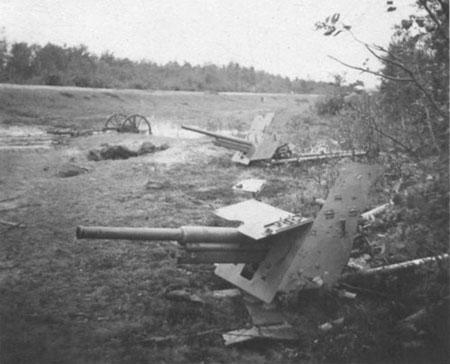 |
Artillery of the Red Army
Part Three: Anti-tank Guns
By Ian Galley
Part I... Part II...
The German invasion of Russia caught the Red Army’s anti-tank arm in a period of transition. The production of older guns and ammunition had been stopped, and factories stood idle or at low production rates while the new designs were being finalised.
The Chief of Artillery at the time was Marshall Kulik. Kulik had become obsessed with the idea that the Germans possessed very heavily armoured tanks, like the Soviets own KV and T-34 series (which they did not).
|
Stalin believed him, and to combat theses mythical German tanks a range of heavy calibre guns was being designed. The new standard calibre gun was to be the 107mm, a powerful weapon that at the time of the invasion had been produced in only low numbers by the Novorcherassk plant. Production of 45mm and 76mm guns and ammunition had been halted. (The situation was similar in the Red Army tank arm, with production of spares for the BT and T-26 series vehicles halted as the T-34 and KVs began to enter production.)
|
The result was an under-resourced anti-tank arm to meet the German invasion. It was quickly discovered that the armour on most German tanks was not very heavy, and the standard 45mm gun was adequate to deal with them. The decision to cancel production of 45mm and 76mm weapons was immediately rescinded and these calibres served on until the end of the war and beyond.
|
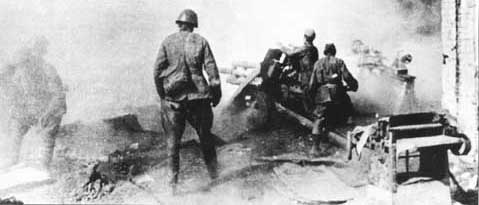 |
Anti-tank ammunition
The Red army primarily used two types of armour piercing projectiles – Armour Piercing Ballistic Capped High Explosive (APBC-HE) and Armour Piercing Composite Rigid (APCR). Some weapons also fired a High Explosive Anti-tank (HEAT) round.
|
|
APBC-HE
This is an improved version of the basic solid shot steel projectile (or AP round) fired at an armoured target at high speed. The projectile hits the target, sticks and transfers enough kinetic energy to the armour to overcome the bonding of the molecules in that armour. If the kinetic energy in the anti-tank projectile is sufficient the penetrator slides through the metal just like the proverbial hot knife through butter.
One problem with the solid shot is that the best shape of the front is usually not very streamlined (i.e. it has poor ballistic characteristics). So a light cone was placed over the front of the projectile to make it fly to the target without losing as much speed. This is called a Ballistic Cap (BC).
Once the tank’s armour has been overcome then the projectile goes on to do as much damage inside the vehicle as possible, hopefully knocking it out. Even a simple solid shot round can do a lot of damage through the projectile itself crashing into things, from fragments of the tank’s own armour spraying around inside, from the overpressure of the projectile suddenly entering the confined space of the tank, and from the psychological impact of this penetration on the tank crew (collectively known as ‘behind armour effects’). To improve the behind armour effects of the AP projectile it was usually filled with High Explosive (HE). Once inside the tank the idea was that the shell would explode, doing an awful lot of damage.
Putting all these components together produces the APBC-HE projectile.
|
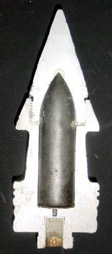 |
APCR
Armour Piercing Composite Rigid (APCR, also knows as sub-calibre or arrowhead shot) is a special type of ammunition that was highly effective but very expensive to make. This round consists of a small penetrator made of a very dense material (usually tungsten) which is encased is a lighter outer shell. Because the material is very dense it weighs a lot for its size, and the smaller calibre of it allows the round to focus its kinetic energy on a smaller area of the target. The overall lighter weight of the round allows it to be fired at a higher velocity (and the faster it moves, the more kinetic energy it has). The Red Army developed APCR rounds after examining captured German stocks of arrowhead ammunition. Only very limited quantities were issued to troops -- a tank might be lucky to be carrying four sub-calibre rounds, for example.
In US service this type of shot was called High Velocity Armor Piercing (HVAP). The British used a variation of this shot called Armour Piercing Discarding Sabot (APDS) or Super Velocity Discarding Sabot (SVDS), in which instead of carrying the outer shell (or sabot) along for the flight, it is discarded immediately after leaving the gun barrel, leaving the penetrator to travel to the target alone.
|
|
Sub-calibre rounds had their disadvantages. They were expensive to make and so issued in limited quantities. Their high-velocity and light weight could make them less accurate at longer ranges. And because the amount of metal that ended up penetrating the enemy tank was quite small (and they did not explode), their behind armour effects could be less than that of a full-calibre round.
Early problems with Soviet ammunition
Soviet armour piercing ammunition in the early-war period was of low quality. The ammunition had poor quality fuses (often resulting in the round exploding before it had fully penetrated the tank’s armour), and were poorly engineered (causing the shell to disintegrate on impact with the enemy tank). As a result the Russian anti-tank guns did not always perform up to expectations. The quality problems with Soviet ammunition were not completely rectified until 1944.
Ammunition was also in short supply for many weapons, as production had been halted in preparation for the new generation of guns. Ammunition production was hurriedly restarted after the German invasion but shortages still caused problems in the early war period.
|
|
The weapons
Here is a brief review of the major anti-tank guns used by the Red Army. As noted in the previous parts of this series, Soviet doctrine emphasised all guns were expected to engage enemy tanks (even if they only had HE ammunition) as they appeared. So all Soviet guns were employed as anti-tank weapons as the situation demanded.
The ‘length of piece’ figures given are measured from the rear face of the breech ring to the end of the barrel. Generally, the longer the barrel on a gun, the higher the velocity of the projectile and so the better its armour penetration is.
The armour penetration figures are mostly useful for comparing different Soviet guns. Each nation had different methods for determining the penetration capabilities of their guns, so these figures cannot be used to make precise comparisons with other nation’s guns. Also, many Soviet penetration figures are derived from mathematical calculations, not real life tests.
|
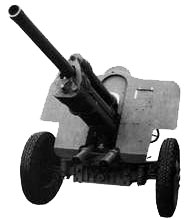 |
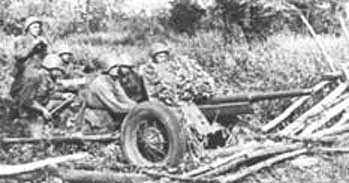 |
45mm M.1932 and M.1937
45mm M.1938
45mm M.1942
The standard Soviet anti-tank gun at the start of the war. The weapon is essentially a scaled up development of German Pak36 37mm gun (the Russians license-built the German gun as the 37mm M.1930). The 45mm was an effective weapon with excellent armour penetration for its size.
|
|
However, it was hampered early on by poor
quality ammunition, and by 1943 increases in tank armour thickness
meant it struggled to perform in the anti-tank role. The weapon served
throughout the entire war and after, despite its small calibre, and its
capability to fire high-explosive meant it could be used in an infantry
support role.
One temporary version of the 45mm gun was in service in 1941 and 42. In a desperate attempt to replace anti-tank gun losses the M.1938 45mm tank gun was mounted on a field carriage.
|
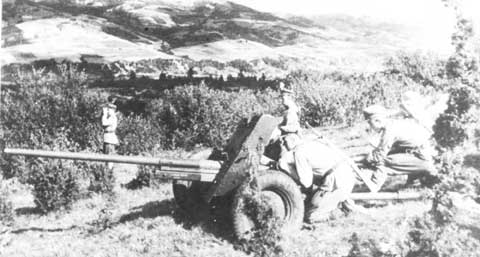 |
|
These were only ever a short-term solution and not mass-produced.
45mm obr 1938 and 1942 guns
Calibre: 45mm/L46 or L/66
Shell weight: 1.43kg.3.151lb
Length of piece: 2072.5mm/(M.1932/37/38), 2967mm/(M.1942)
Armour penetration: M.1932/37/38: 43mm @ 500m (AP)
M.1942: 61mm @500m (AP). 81mm (APCR)
Weight: 450kg/990lb (M.1932/37/38), 570kg/1257lb (M.1942)
|
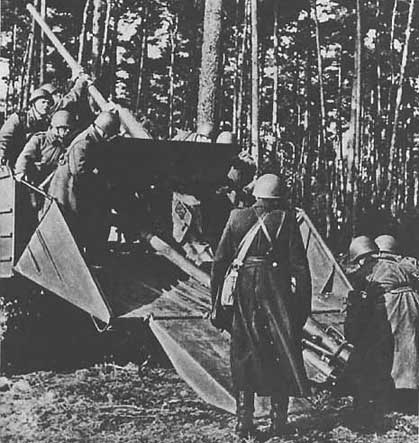 |
57mm ZIS-2
This was a very long-barrelled gun with excellent armour penetration. It was available in 1941, but was cancelled in December 41 because of the lack of heavy German tanks (it was felt that the weapon was over-powerful against the thinly-armoured German tanks of 1941), and also because of the expense involved in its manufacture.
The initial production batch was very inaccurate as the calculations for the rifling inside the barrel were botched. By the time this had been rectified and production restarted it was cancelled in favour of the 76mm field gun. The 76mm was felt to have adequate armour penetration and also fired a much better high-explosive round.
The power of the 57mm was needed when the new generation of German heavy tanks appeared in 1942, and the weapon re-entered service in 1943 on a modified gun carriage.
|
The gun was also mounted in a tank-killer version of the T-34 (the T-34/57), which saw limited service in the mid-war period.
57mm ZIS-2 gun
Calibre: 57mm/L73
Shot weight: 3.148kg/6.94lb
Length of piece: 4162mm/163.8 in
Armour penetration: 115mm @ 500m (APBC-HE). 155mm (APCR)
Weight of weapon: 1150kg
|
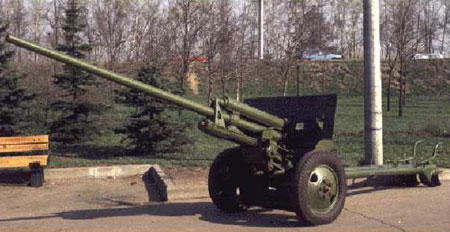 |
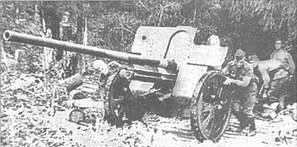 |
76mm F-22 M.1936
At the start of the war the standard 76mm divisional gun was the M.1936. A powerful weapon, but heavy and expensive to produce. The M.1936 was being replaced by the improved version, the M.1939 USV (usovershenstvovannaya, or modernised and improved). The Germans used many captured M.1936 (designated Pak36(r)) because of its excellent A/T performance. The M.1939 (Pak39(r)) was also captured and used by the Germans.
|
|
76mm F-22 M.1936 (available as the Pak36(r))
Calibre: 76.2mm/L51.1
Shell weight: 6.4kg/14.1lb
Length of piece: 3895mm/153.3in
Armour penetration: 75mm @ 500m (APBC-HE)
Weight of weapon: 1350kg/2976lb
Right: 76mm M.1939 USV gun on similar trail to the 76mm F-22 mdel 1926 field gun.
|
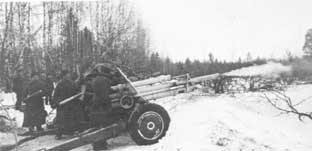
|
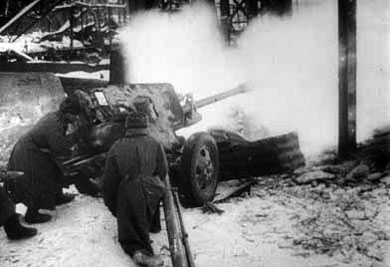 |
76mm ZIS-3
In 1942 the 76mm M.1939 USV gun was mounted on the same carriage as used by the ZIS-2 and designated the ZIS-3 (ZIS means Zavod imeni Stalina, or Stalin’s factory).
|
|
85mm KS-12 M.1939
A very modern anti-aircraft gun that, like the infamous German 8,8cm Flak18/36, had excellent armour-piercing capability. Not entirely suited to use in the A/T role, due to the height of the weapon, and often the lack of a gun-shield.
The gun was pressed into service in anti-tank regiments in 1941 due to shortage of 76mm weapons. The Russians preferred to reserve the weapon for its anti-aircraft role however and once supplies of 76mm guns were sufficient the 85mm was most often kept away from the frontline.
A notable exception is the battle of Kursk, 1943, in which batteries of 85mm guns were deployed in the anti-tank role.
Even during Operation Bagration large numbers were still in use as anti-tank guns.
85mm obr 1939
Calibre: 85mm/L55
Shell weight: 9.2kg/20lb
Length of piece: 4693mm/184.7in
Armour penetration: 103mm @ 500m
Weight of weapon: 3057kg/6739.5lb
Right: The 85mm M.1939 deployed in an anti-aircraft role.
|
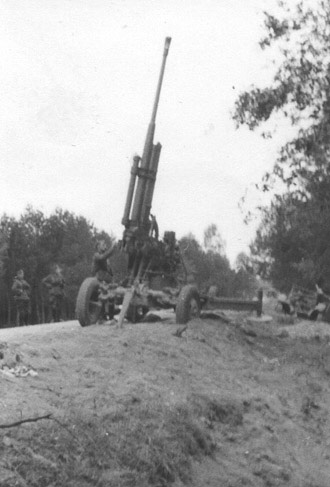 |
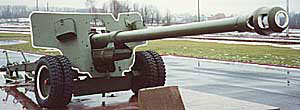 |
100mm BS-3 M.1944
It was felt that a new gun was required to combat the more powerful German tanks. Chief artillery designer for the Red Army, General V. G. Grabin, turned to the 100mm naval gun. The BS-3 appeared in numbers in late 1944 and was intended to replace 76mm gun batteries in the anti-tank regiments, but never entirely did.
|
|
Only 591 BS-3 ATGs were produced before the end of the war, and only 185 were in troop service in January 1945.
The same tube was mounted in the SU-100 assault gun. One of the most powerful anti-tank guns of the war and was capable of knocking out most German tanks from considerable range.
|
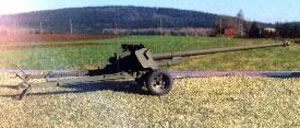 |
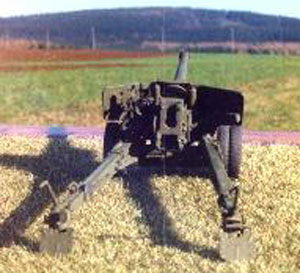 |
In his book “Red Hammers” (Soviet Self-propelled Artillery and Lend Lease Armor 1941-1945, Soviet Order Of Battle World War II Volume XII, Charles C Sharp, 1998, George F Nafziger), Charles Sharp notes that “The 100mm cannon especially was effective against all German tanks, including the 76-ton Koenigtiger, or ‘King Tiger’. As one Soviet veteran commented long after the war:
‘…the 100mm couldn’t penetrate the King Tiger at a range of 1000 meters. The crew was put out of action (author’s emphasis) but the tank was not penetrated…’
Which is another way of saying that when the 100mm projectile hit the front of a tank with 1200-foot pounds of energy, penetration of the armor was only part of the tank crew’s worries.” (p. 5)
|
|
Evgenii Monyushko remembers his one and only encounter with a BS-3 during the war:
“On the way, despite the deficit of time, we spent a quarter of an hour to look at the visual demonstration of the new 100mm gun’s merits -- a "sotka", as it was called. By the way, this was the first and only time I ever saw it in action. The "sotka" turned up here while passing through, as they say. A lone tracked tractor was pulling the single gun to somewhere along the front line. Infantry that was in their positions somewhere on the edge of a farm, had stopped the tractor, and the soldiers tried to talk the senior lieutenant into "scaring" a German tank which they had seen in a village at the distance of a kilometer and a half. The "senior" tried to wave them off, but then he got interested, looked. Kolechko and I also got interested and decided to see how it would end. The gun crew detached the gun on the senior lieutenant’s order and rolled it to a convenient spot, assisted by the infantrymen. While they were preparing the gun for action, the tractor turned and backed toward the gun. They took a single shell out of the box, carefully aimed the gun, having determined the distance to set the sight by the map. A single shot -- the tracer shell pierced the armor and the tank burst into flames. And the "gunners", not wasting any time, were already attaching the gun to the tractor. I wished that we had such a gun in 1944 in our IPTAP (anti-tank artillery regiment) at the Sandomierz bridgehead.”
100mm obr 1944 gun
Calibre: 100mm/L59
Shell weight: 15.6kg/34.4lb
Length of piece: 5969mm/235in
Armour penetration: 185mm @ 500m
Weight of weapon: 3460kg/ 7628.5lb
|
|
107mm M-60 M.1939
The 107mm M-60 model 1939 was intended to replace regimental and divisional anti-tank weapons in the Soviet army. It saw limited service in 1941. Only 127 guns were produced before the factory in Novocherkassk was overrun in autumn 1941, and production was never restarted.
107mm M-60 M.1939
Calibre: 107mm/48
Shell weight: 18.86kg
Length of piece: 5136mm/202.2in
Armour penetration: 130mm @ 500m
Weight of weapon: 4000kg/8,818.5lb
|
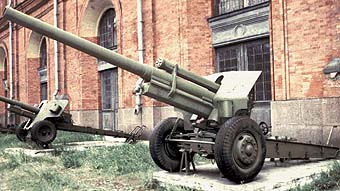 |
And that concludes our look at Artillery of the Red Army. This series has just skimmed the surface of many aspects of Soviet artillery and I hope this has stimulated your interest in the area and that you conduct your own research into the topic!
Ian
|
Last Updated On Thursday, January 17, 2013 by Wayne at Battlefront
|
|
|